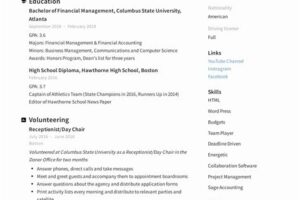Table of Contents
A volunteer job description outlines the roles, responsibilities, and expectations for individuals who are willing to offer their time and skills for a good cause. It provides a clear understanding of the tasks to be performed, the time commitment required, and any specific skills or qualifications needed. A well-written volunteer job description helps organizations attract suitable volunteers and ensures that both parties have a mutually beneficial experience.
A volunteer job description is a crucial document that outlines the roles, responsibilities, and expectations associated with a particular volunteer position. It serves as a guide for both the organization and the volunteers, ensuring clarity and alignment in their efforts. Whether you are a prospective volunteer or an organization looking to recruit volunteers, understanding the importance of a well-defined job description is key. From setting clear goals to establishing boundaries, a comprehensive job description can help create a positive and productive volunteering experience for all involved.
Introduction
A volunteer job description is a document that outlines the responsibilities, requirements, and expectations of individuals who are willing to contribute their time and skills to a non-profit organization or a community project. It serves as a guide for both the volunteers and the organization, ensuring that there is clarity and understanding about the role and what is expected from the volunteer. This article will delve into the key components of a volunteer job description and the importance of having one.
The Purpose of a Volunteer Job Description
A volunteer job description serves several important purposes:
- It provides potential volunteers with a clear understanding of the role and responsibilities they will undertake.
- It helps the organization recruit suitable volunteers by clearly outlining the qualifications, skills, and experience required for the position.
- It sets expectations for the volunteer’s commitment, such as the number of hours required, the duration of the volunteer position, and any specific time commitments.
- It helps the organization effectively manage and supervise volunteers by establishing guidelines and boundaries for their work.
- It ensures consistency and fairness in the treatment of volunteers by clearly stating the benefits, training opportunities, and resources available to them.
Components of a Volunteer Job Description
A well-written volunteer job description typically includes the following components:
Title and Overview
The title of the volunteer position should accurately reflect the role and responsibilities. The overview provides a brief description of the position and its purpose within the organization or project.
Responsibilities
This section outlines the specific tasks and duties that the volunteer will be expected to perform. It is important to be clear and concise, using action verbs to describe each responsibility.
Qualifications and Skills
Here, the organization specifies the qualifications, skills, and experience required for the volunteer position. This could include educational background, certifications, or specific technical skills.
Time Commitment
The time commitment section clarifies the expected number of hours per week or month, the duration of the volunteer position, and any specific time requirements such as evenings or weekends.
Training and Support
Organizations should outline any training opportunities provided to volunteers to enhance their skills or knowledge related to the position. This section also includes information about the support available to volunteers, such as a designated supervisor or mentor.
Benefits
While most volunteer positions are unpaid, organizations may offer benefits such as reimbursement for expenses, access to resources, or networking opportunities. This section highlights the benefits available to volunteers.
Code of Conduct
A code of conduct sets expectations for the behavior and professionalism of volunteers, ensuring a safe and respectful environment. It may include guidelines on confidentiality, communication, and adherence to organizational policies.
Supervision and Reporting
This section explains the reporting structure and who the volunteer will be accountable to. It outlines the supervision and evaluation process, as well as any reporting requirements.
Physical Requirements
If the volunteer position requires physical exertion or has specific physical requirements, such as lifting heavy objects or standing for extended periods, this section should clearly state those requirements.
Additional Information
Organizations can include any additional information relevant to the volunteer position, such as travel requirements, specific project details, or any other expectations not covered in the previous sections.
The Importance of a Volunteer Job Description
A well-crafted volunteer job description is crucial for several reasons:
- It attracts the right candidates who possess the necessary qualifications and skills.
- It sets clear expectations for both the volunteer and the organization.
- It helps the organization effectively manage and supervise volunteers.
- It ensures consistency in the treatment of volunteers and promotes fairness and transparency.
- It minimizes misunderstandings and conflicts by providing clarity about the role and responsibilities.
Conclusion
A volunteer job description is an essential tool for organizations seeking to recruit, manage, and support volunteers. By clearly outlining the role, responsibilities, and expectations, organizations can attract suitable candidates and ensure a positive volunteering experience for all parties involved. It serves as a foundation for effective volunteer management and contributes to the success of non-profit organizations and community projects.
Title and Role
The volunteer job description begins with a clear and concise title that reflects the role they will fulfill within the organization. This section outlines the specific duties and responsibilities the volunteer will be expected to undertake during their time with the organization.
Purpose and Objective
This subheading focuses on the overall purpose and objective of the volunteer position. It explains how the role contributes to the organization’s mission and goals, and what impact the volunteer’s efforts will have on the community or target audience.
Essential Qualifications
Here, the volunteer job description highlights the essential qualifications necessary for the position. This includes any specific skills, experience, or training required by the organization to carry out the tasks effectively. It also mentions any desired personal attributes or qualities that would enhance the volunteer’s ability to fulfill their role successfully.
Key Responsibilities
This section outlines the core responsibilities and tasks that the volunteer will be expected to undertake regularly. It provides a comprehensive list of all the duties they will be required to perform, ensuring a clear understanding of what is expected from them.
Time Commitment
This subheading addresses the expected time commitment of the volunteer position. It includes the duration and frequency of volunteer work, whether it is a one-time event, short-term project, or an ongoing commitment. Understanding the time requirements is crucial for both the organization and the volunteer to ensure they can meet each other’s expectations.
Reporting and Supervision
This section details the reporting structure and supervision arrangements for the volunteer position. It outlines who the volunteer will report to, who will provide guidance and support, and how they will be evaluated or assessed on their performance.
Training and Development
Here, the volunteer job description highlights any training or development opportunities available to the volunteer. It may include information about initial training sessions, ongoing skill-building workshops, or access to resources and educational materials. This section emphasizes the organization’s commitment to providing a meaningful learning experience for volunteers.
Benefits and Rewards
The final subheading focuses on the benefits and rewards of the volunteer position. It may include non-monetary rewards such as networking opportunities, personal growth, or satisfaction gained from making a positive impact. If applicable, it may also mention any stipends, travel reimbursements, or other benefits volunteers may receive.
Volunteering is an invaluable service that individuals provide to organizations and communities. To ensure a successful volunteer experience, it is essential to have a well-defined volunteer job description. The volunteer job description serves as a guide for both the organization and the volunteer, outlining the expectations, responsibilities, and benefits associated with the position.The first section of the volunteer job description is the title and role. This section provides a clear and concise title that reflects the specific role the volunteer will fulfill within the organization. For example, if the volunteer will be assisting with event planning, the title might be Event Planning Volunteer. Following the title, the job description outlines the specific duties and responsibilities the volunteer will be expected to undertake during their time with the organization. This section ensures that both the organization and the volunteer have a clear understanding of what is expected from them.The purpose and objective of the volunteer position are crucial aspects addressed in the job description. This subheading explains how the role contributes to the organization’s overall mission and goals. It also highlights the impact that the volunteer’s efforts will have on the community or target audience. This section helps the volunteer understand the significance of their role and motivates them to contribute effectively.Essential qualifications are outlined in the volunteer job description to ensure that the organization finds the right fit for the position. This section highlights any specific skills, experience, or training required by the organization to carry out the tasks effectively. It may also mention desired personal attributes or qualities that would enhance the volunteer’s ability to fulfill their role successfully. By clearly stating these qualifications, the organization can attract volunteers who possess the necessary skills and attributes.The key responsibilities section of the job description provides a detailed list of the core duties and tasks that the volunteer will be expected to undertake regularly. This comprehensive list ensures that the volunteer has a clear understanding of their role within the organization. It also allows the organization to delegate responsibilities effectively and efficiently.Understanding the time commitment of the volunteer position is crucial for both the organization and the volunteer. The time commitment section addresses the duration and frequency of the volunteer work. It clarifies whether the position is a one-time event, a short-term project, or an ongoing commitment. This information helps the organization plan and schedule volunteer activities effectively. It also allows the volunteer to assess whether they can meet the time requirements and manage their other commitments accordingly.The reporting and supervision section outlines the reporting structure and supervision arrangements for the volunteer position. It specifies who the volunteer will report to, who will provide guidance and support, and how their performance will be evaluated or assessed. Clear communication channels and supervision arrangements are essential for volunteers to receive the necessary guidance and support, ensuring they can perform their duties effectively.Training and development opportunities are highlighted in the volunteer job description to emphasize the organization’s commitment to providing a meaningful learning experience for volunteers. This section may include information about initial training sessions, ongoing skill-building workshops, or access to resources and educational materials. By providing these opportunities, the organization equips volunteers with the necessary knowledge and skills to excel in their roles.Finally, the benefits and rewards section focuses on the non-monetary rewards that volunteers may receive. This may include networking opportunities, personal growth, or the satisfaction gained from making a positive impact. If applicable, the job description may also mention any stipends, travel reimbursements, or other benefits volunteers may receive. Recognizing and acknowledging the contributions of volunteers is essential for their motivation and continued engagement.In conclusion, a well-defined volunteer job description is crucial for both the organization and the volunteer. It provides clarity on the expectations, responsibilities, and benefits associated with the position. By addressing the title and role, purpose and objective, essential qualifications, key responsibilities, time commitment, reporting and supervision, training and development, and benefits and rewards, the job description ensures a positive and fulfilling volunteer experience for all parties involved.
In a professional context, a volunteer job description serves as a crucial tool for organizations to effectively communicate the expectations and responsibilities associated with a volunteer role. By providing a clear and concise outline of the tasks and duties involved, a volunteer job description helps both the organization and potential volunteers understand what is required.
Here are several key points to consider when creating a volunteer job description:
- Title and Overview: Begin by providing a title that accurately reflects the volunteer position. Follow this with a brief overview of the organization and its mission, highlighting how the role contributes to achieving these goals.
- Objective: Clearly state the objective of the volunteer position. This could include assisting in specific projects, supporting daily operations, or providing direct services to individuals or communities.
- Responsibilities: Use bullet points or numbered lists to outline the specific tasks and duties associated with the role. Be detailed and precise, ensuring that potential volunteers have a comprehensive understanding of what is expected of them.
- Qualifications: Specify any desired qualifications, skills, or experience necessary to fulfill the volunteer position effectively. This could include educational background, technical skills, language proficiency, or previous volunteer experience.
- Time Commitment: Clearly define the time commitment required for the volunteer role, specifying the number of hours per week or month, and if there are any specific days or times when the volunteer is expected to be available.
- Supervision and Support: Outline the level of supervision and support that will be provided to the volunteer, including any training or orientation sessions, regular check-ins, and points of contact within the organization.
- Benefits: Highlight any benefits or rewards associated with the volunteer position, such as networking opportunities, letters of recommendation, or personal and professional development.
- Code of Conduct: Clearly communicate the organization’s code of conduct and the expected behavior of volunteers. This could include maintaining confidentiality, adhering to ethical guidelines, and treating all individuals with respect and dignity.
- Application Process: Provide information on how interested individuals can apply for the volunteer position, including any necessary application forms, interviews, or background checks.
- Closing: Conclude the job description by expressing gratitude for the interest in volunteering and encouraging potential volunteers to apply or reach out with any further questions.
A well-crafted volunteer job description not only helps organizations attract suitable candidates but also ensures that volunteers have a clear understanding of their role and responsibilities. By using a professional voice and tone, organizations can effectively convey the importance of the volunteer position and the impact it has on their overall mission.
Thank you for visiting our blog and taking the time to learn about what a volunteer job description entails. Volunteering is a noble act that not only benefits those in need but also provides immense personal growth and fulfillment. In this article, we have explored the significance of volunteer job descriptions and how they play a crucial role in ensuring effective volunteer management.
Firstly, understanding the volunteer job description is vital as it sets clear expectations and responsibilities for both the organization and the volunteers. By providing detailed information about the tasks, skills required, and time commitment, the volunteer job description serves as a guide for potential volunteers to make informed decisions about their involvement. It helps them assess whether they possess the necessary skills and availability to meet the organization’s needs effectively. Furthermore, a well-defined job description helps organizations attract individuals who are genuinely interested in the cause and possess the desired skills, ensuring a better match between the volunteer and the organization.
Secondly, volunteer job descriptions promote transparency and accountability. When volunteers have a clear understanding of their roles and responsibilities, they can perform their tasks more efficiently and effectively. This clarity minimizes confusion and prevents misunderstandings between the organization and the volunteers. Moreover, a comprehensive job description allows volunteers to hold themselves accountable for their commitments and deliverables. They can evaluate their performance against the outlined expectations, making it easier for them to identify areas for improvement or seek guidance and support when needed.
Lastly, volunteer job descriptions facilitate proper volunteer management and supervision. By clearly outlining the tasks and skills required, organizations can ensure that they have the right volunteers for each role. This enables effective delegation and distribution of responsibilities, preventing burnout and ensuring a smooth workflow. Additionally, a well-crafted job description helps supervisors provide guidance and support to volunteers, as they have a clear understanding of what is expected from them in terms of performance and outcomes.
In conclusion, volunteer job descriptions are essential tools for effective volunteer management. They provide clarity, transparency, and accountability to both the organization and the volunteers. By setting clear expectations and outlining responsibilities, job descriptions facilitate better matching of skills and interests, resulting in a more meaningful and impactful volunteering experience. So, whether you are an organization looking to recruit volunteers or an individual considering volunteering, understanding and utilizing volunteer job descriptions will undoubtedly contribute to a successful and rewarding journey.
Video What Is A Volunteer Job Description
People also ask about What Is A Volunteer Job Description?
What should be included in a volunteer job description?
A volunteer job description typically includes the following information:
- The name and mission of the organization
- The title of the volunteer position
- A brief overview of the role and responsibilities
- The time commitment required
- The desired skills and qualifications
- Any necessary training or orientation
- The benefits or rewards of volunteering
- Contact information for the organization
How do you write a volunteer description?
To write an effective volunteer job description, follow these steps:
- Start with a catchy title that accurately represents the position.
- Provide a brief overview of the organization and its mission.
- Clearly outline the specific duties and responsibilities of the volunteer role.
- Mention any required skills, qualifications, or previous experience.
- Specify the time commitment needed and whether it’s a one-time or ongoing opportunity.
- Highlight any benefits or rewards that volunteers can expect.
- Include contact information for interested individuals to inquire or apply.
Why is a volunteer job description important?
A volunteer job description is important because it:
- Sets clear expectations for both the organization and the volunteer
- Helps attract individuals with the right skills and qualifications
- Aids in the recruitment process by providing accurate information
- Serves as a reference point for volunteers to understand their responsibilities
- Establishes a foundation for evaluating volunteer performance
Where can I find examples of volunteer job descriptions?
You can find examples of volunteer job descriptions on various websites, including:
- VolunteerMatch (www.volunteermatch.org)
- Idealist (www.idealist.org)
- Your local nonprofit organizations’ websites
Can a volunteer job description be modified?
Yes, a volunteer job description can be modified to suit the specific needs of an organization or to reflect changes in the volunteer role over time. It is important to keep the description up to date and accurate to ensure that potential volunteers have the right information.






